An Estimation of the Energy Savings of a Mainline Diesel Locomotive Equipped with an Energy Storage Device
Abstract
1. Introduction
- -
- A mathematical model of the movement of the main diesel locomotive is developed in Section 2;
- -
- The movement of a diesel locomotive as part of a train is modeled for the following options in Section 3: movement with a serial diesel locomotive; movement with a diesel locomotive as part of one diesel and booster section with an energy accumulator (energy exchange is carried out only with the traction system of the booster section); movement with a diesel locomotive as part of one diesel and booster section with an energy accumulator (energy exchange is carried out with the traction systems of the diesel and booster sections);
- -
- The obtained results are discussed in Section 4;
- -
- Conclusions are drawn in Section 5.
2. Development of a Mathematical Model of Train Movement
- v—train speed;
- t—time;
- S—path;
- ρ—coefficient that takes into account the rotation of the parts of the locomotive subframe;
- fL—specific traction force of the locomotive in traction or electrodynamic braking mode;
- wL—specific resistance force of the locomotive movement;
- wW—specific force of resistance to movement of wagons;
- b—specific braking force of pneumatic brakes.
- MLk—mass of the locomotive section;
- s—the number of locomotive sections;
- MWj—mass of the wagon;
- n—the number of wagons.
- wi—additional specific resistance to movement from a slope;
- wr—additional specific resistance of movement from movement along a curve;
- ws—additional specific resistance during train movement.
- g—acceleration of free fall.
- gi—specific fuel consumption at the i-th position of the driver’s controller;
- τi—total duration of diesel operation at the i-th position of the driver’s controller;
- g0—specific fuel consumption in idle mode;
- τ0—total duration of diesel engine operation in idling mode;
- N—total number of driver controller positions.
- ED—theoretical value of the energy that a diesel engine could produce when operating at rated power during movement.
- T2—total duration of coasting mode during movement along the section;
- T3—total duration of braking mode, including electrodynamic braking.
- AT—work “on the wheel” of traction forces;
- ηR—average value of the efficiency of the traction system and the energy storage system during accumulation;
- γAUX—share of energy consumed by auxiliary systems in electrodynamic braking mode;
- γB—share of energy that is utilized by other braking systems during braking.
- -
- The average value of the efficiency of the traction system and the energy storage system during accumulation is 0.9;
- -
- The share of energy consumed by auxiliary systems in electrodynamic braking mode: γAUX = 0.05;
- -
- The share of energy that, during braking, is utilized by other braking systems: γB = 0.06.
3. Results of Train Motion Simulation
3.1. Modeling the Movement of a Train with a Serial Diesel Locomotive (Option 1)
3.2. Modeling the Movement of a Train with a Diesel Locomotive as Part of Diesel Sections and a Booster Section with Energy Storage (Option 2)
- ηTD—total efficiency of traction electric drive (accepted efficiency equal to 0.9 for traction mode and electrodynamic braking mode);
- PauxB—power of auxiliary systems of the booster section (taken equal to 150 kW).
- Δt—duration of the charging (discharging) process.
3.3. Modeling the Movement of a Train with a Diesel Locomotive as Part of a Diesel Section and a Booster Section with an Energy Storage Unit with Combined Traction Systems (Option 3)
- PauxD—the power of auxiliary systems of the diesel section (taken to be equal to 200 kW);
- Pk—tangential power of the diesel locomotive.
4. Discussion of the Obtained Results
5. Conclusions
Author Contributions
Funding
Data Availability Statement
Conflicts of Interest
References
- Available online: https://transport.ec.europa.eu/transport-themes/infrastructure-and-investment/trans-european-transport-network-ten-t_en (accessed on 1 February 2024).
- Kharchuk, O.; Kryvenko, O. Railway International Transport Corridors Ukraine and Role USCTS «Liski» in Their Development. Int. Sci. J. Internauka 2017, 15, 63–68. (In Ukrainian) [Google Scholar]
- Available online: https://www.uz.gov.ua/press_center/up_to_date_topic/607214/ (accessed on 1 February 2024).
- Smyrnov, I.; Lyubitseva, O.; Zapototskyi, S.; Hryniuk, D.; Stepanets, I. European Transport Corridors: Experience and Opportunities for Ukraine in Times of Danger. In Smart Technologies in Urban Engineering. STUE 2023; Lecture Notes in Networks and Systems, Arsenyeva, O., Romanova, T., Sukhonos, M., Biletskyi, I., Tsegelnyk, Y., Eds.; Springer: Cham, Switzerland, 2023; Volume 807. [Google Scholar] [CrossRef]
- Available online: https://www.wabteccorp.com/locomotive/heavy-haul-locomotives/es44aci-locomotive (accessed on 1 February 2024).
- Available online: https://logist.today/dnevnik_logista/2018-12-17/v-uz-rasskazali-kak-projavil-sebja-lokomotiv-trizub-v-pervyh-rejsah/ (accessed on 1 February 2024).
- Available online: https://finance.bigmir.net/news/2852901-made-in-ukraine-kakie-poezda-mogut-zamenit-staryj-park-ukrzaliznyci (accessed on 1 February 2024).
- Available online: https://trz.com.ua/modernization-ua/ (accessed on 1 February 2024).
- Kljaić, Z.; Pavković, D.; Cipek, M.; Trstenjak, M.; Mlinarić, T.J.; Nikšić, M. An Overview of Current Challenges and Emerging Technologies to Facilitate Increased Energy Efficiency, Safety, and Sustainability of Railway Transport. Future Internet 2023, 15, 347. [Google Scholar] [CrossRef]
- Cipek, M.; Pavković, D.; Kljaić, Z.; Trstenjak, M.; Mlinarić, T.J. Assessment of Battery-Hybrid Diesel-Electric Locomotive Fuel Savings and Emission Reduction Potentials Based on a Realistic Mountainous Rail Route. Energy 2019, 173, 1154–1171. [Google Scholar] [CrossRef]
- Mayrink, S., Jr.; Oliveira, J.G.; Dias, B.H.; Oliveira, L.W.; Ochoa, J.S.; Rosseti, G.S. Regenerative Braking for Energy Recovering in Diesel-Electric Freight Trains: A Technical and Economic Evaluation. Energies 2020, 13, 963. [Google Scholar] [CrossRef]
- Saeed, M.; Briz, F.; Guerrero, J.M.; Larrazabal, I.; Ortega, D. Onboard Energy Storage Systems for Railway: Present and Trends. Open J. Ind. Appl. 2023, 4, 238–259. [Google Scholar] [CrossRef]
- Li, W.; Wang, C.; Pei, H.; Xu, C.; Lin, G.; Deng, J.; Jiang, D.; Huang, Y. An Improved Energy Management Strategy of Diesel-Electric Hybrid Propulsion System Based on FNN-DP Strategy. Electronics 2023, 12, 486. [Google Scholar] [CrossRef]
- Meinert, M.; Prenleloup, P.; Schmid, S.; Palacin, R. Energy Storage Technologies and Hybrid Architectures for Specific Diesel-Driven Rail Duty Cycles: Design and System Integration Aspects. Appl. Energy 2015, 157, 619–629. [Google Scholar] [CrossRef]
- Available online: https://www.wabteccorp.com/locomotive/alternative-fuellocomotives/flxdrive (accessed on 1 February 2024).
- Sun, Y.; Cole, C.; Spiryagin, M.; Godber, T.; Hames, S.; Rasul, M. Conceptual Designs of Hybrid Locomotives for Application as Heavy Haul Trains on Typical Track Lines. Proc. Inst. Mech. Eng. Part F J. Rail Rapid Transit 2013, 227, 439–452. [Google Scholar] [CrossRef]
- da Silva Moraes, C.G.; Brockveld, S.L.; Heldwein, M.L.; Franca, A.S.; Vaccari, A.S.; Waltrich, G. Power Conversion Technologies for a Hybrid Energy Storage System in Diesel-Electric Locomotives. IEEE Trans. Ind. Electron. 2021, 68, 9081–9091. [Google Scholar] [CrossRef]
- Fedele, E.; Iannuzzi, D.; Pizzo, A.D. Onboard Energy Storage in Rail Transport: Review of Real Applications and Techno-Economic Assessments. IET Electr. Syst. Transp. 2021, 11, 279–309. [Google Scholar] [CrossRef]
- Omelyanenko, V.I.; Riabov, I.S.; Overianova, L.V.; Omelianenko, H.V. Traction Electric Drive Based on Fuel Cell Batteries and On-Board Inertial Energy Storage for Multi Unit Train. Electr. Eng. Electromechan. 2021, 4, 64–72. [Google Scholar] [CrossRef]
- Kapetanović, M.; Núñez, A.; van Oort, N.; Goverde, R.M.P. Reducing Fuel Consumption and Related Emissions Through Optimal Sizing of Energy Storage Systems for Diesel-Electric Trains. Appl. Energy 2021, 294, 117018. [Google Scholar] [CrossRef]
- Mayet, C.; Pouget, J.; Bouscayrol, A.; Lhomme, W. Influence of an Energy Storage System on the Energy Consumption of a Diesel-Electric Locomotive. IEEE Trans. Veh. Technol. 2014, 63, 1032–1040. [Google Scholar] [CrossRef]
- Shiraki, N.; Satou, H.; Arai, S. A Hybrid System for Diesel Railcar Series Ki-Ha E200. In Proceedings of the 2010 International Power Electronics Conference—ECCE ASIA, Sapporo, Japan, 21–24 June 2010; pp. 2853–2858. [Google Scholar] [CrossRef]
- Fayad, A.; Ibrahim, H.; Ilinca, A.; Sattarpanah Karganroudi, S.; Issa, M. Energy Recovering Using Regenerative Braking in Diesel–Electric Passenger Trains: Economical and Technical Analysis of Fuel Savings and GHG Emission Reductions. Energies 2022, 15, 37. [Google Scholar] [CrossRef]
- Barbosa, F.C. Battery Only Electric Traction for Freight Trains—A Technical and Operational Assessment. Proc. Inst. Mech. Eng. Part F J. Rail Rapid Transit 2023, 238, 322–337. [Google Scholar] [CrossRef]
- Cipek, M.; Pavković, D.; Krznar, M.; Kljaić, Z.; Trstenjak, M.; Mlinarić, T.J. Comparative Analysis of Conventional Diesel-Electric and Hypothetical Battery-Electric Heavy Haul Locomotive Operation in Terms of Fuel Savings and Emissions Reduction Potentials. Energy 2021, 232, 121097. [Google Scholar] [CrossRef]
- Iden, M.E. Battery Storage of Propulsion-Energy for Locomotives. In Proceedings of the 2014 Joint Rail Conference, Colorado Springs, CO, USA, 2–4 April 2014. [Google Scholar] [CrossRef]
- Masliev, V. Modern Designs and Dynamics of Railway Rolling Stock; NTU “KhPI”: Kharkiv, Ukraine, 2014. (In Ukrainian) [Google Scholar]
- Zayonchkovskiy, V.; Masliev, V.; Yakunin, D. The General Structure, Thermal Calculations of Power Plants and Issues of Manufacturing Technology for the Crew Part of Diesel Locomotives; NTU “KhPI”: Kharkiv, Ukraine, 2008. (In Ukrainian) [Google Scholar]
- Tartakovsky, E.; Agulov, A.; Falendish, A.; Basov, G. Theory and Design of Locomotives. Part 1. General Characteristics and Structure of Locomotives; NTU “KhPI”: Kharkiv, Ukraine, 2006. (In Ukrainian) [Google Scholar]
- Available online: https://suspilne.media/273737-ukraina-i-moldova-vidnovili-alternativnij-zaliznicnij-marsrut-miz-odesou-ta-dunajskimi-portami/ (accessed on 1 February 2024).
- Krushedolsky, A.; Grishina, E. Adjustment of Diesel Locomotive Characteristics of a Forced Diesel Engine of a Main Diesel Locomotive. Intern. Combust. Engines 2009, 1, 103–106. (In Ukrainian) [Google Scholar]
- Bondarenko, I.; Severino, A.; Olayode, I.O.; Campisi, T.; Neduzha, L. Dynamic Sustainable Processes Simulation to Study Transport Object Efficiency. Infrastructures 2022, 7, 124. [Google Scholar] [CrossRef]
- Bosso, N.; Gugliotta, A.; Zampieri, N. Design and Simulation of a Railway Vehicle for the Transport of People with Reduced Mobility. Shock. Vib. 2018, 2018, 9207639. [Google Scholar] [CrossRef]
- Kalivoda, J.; Neduzha, L. Running Dynamics of Rail Vehicles. Energies 2022, 15, 5843. [Google Scholar] [CrossRef]
- Ye, Z.; Chen, Z.; Zhou, Z.; Zhai, W. Dynamic Modelling of Locomotive with Direct Drive Traction System Considering Electromechanical Coupling Effect. Veh. Syst. Dyn. 2023, 63, 1–24. [Google Scholar] [CrossRef]
- Holub, H.; Dmytrychenko, M.; Kulbovskyi, I.; Sapronova, S. Modeling of Energy-Saving Technologies in Traction Rolling Stock Projects. In Proceedings of the 7th ASRES International Conference on Intelligent Technologies. ICIT 2022, Jakarta, Indonesia, 16–18 December 2022; Lecture Notes in Networks and Systems. Arya, K.V., Tripathi, V.K., Rodriguez, C., Yusuf, E., Eds.; Springer: Singapore, 2023; Volume 683. [Google Scholar] [CrossRef]
- Dižo, J.; Blatnický, M.; Steišūnas, S. Multibody Simulation of Rail Vehicle Running Considering Track Flexibility. In TRANSBALTICA XI: Transportation Science and Technology; TRANSBALTICA 2019. Lecture Notes in Intelligent Transportation and Infrastructure; Gopalakrishnan, K., Prentkovskis, O., Jackiva, I., Junevičius, R., Eds.; Springer: Cham, Switzerland, 2020. [Google Scholar] [CrossRef]
- Sablin, O.; Bosyi, D.; Kuznetsov, V.; Lewczuk, K.; Kebal, I.; Myamlin, S.S. Efficiency of Energy Storage Control in the Electric Transport Systems. Arch. Transp. 2022, 62, 105–122. [Google Scholar] [CrossRef]
- Yatsko, S.; Sytnik, B.; Vashchenko, Y.; Sidorenko, A.; Liubarskyi, B.; Veretennikov, I.; Glebova, M. Comprehensive Approach to Modeling Dynamic Processes in the System of Underground Rail Electric Traction. East.-Eur. J. Enterp. Technol. 2019, 1, 48–57. [Google Scholar] [CrossRef]
- Zou, Z.; Zheng, M.; Lu, Q. Modeling and Simulation of Traction Power Supply System for High-Speed Maglev Train. World Electr. Veh. J. 2022, 13, 82. [Google Scholar] [CrossRef]
- Bondarenko, I.; Lukoševičius, V.; Keršys, R.; Neduzha, L. Investigation of Dynamic Processes of Rolling Stock–Track Interaction: Experimental Realization. Sustainability 2023, 15, 5356. [Google Scholar] [CrossRef]
- Li, L.; Dutta, S.; Dixon, R.; Stewart, E. Railway Track Switch Simulation: A New Dynamic Model for Studying Actuator and Switch Blade Dynamics. Proc. Inst. Mech. Eng. Part F J. Rail Rapid Transit 2023, 237, 775–783. [Google Scholar] [CrossRef]
- Holub, H.; Kulbovskyi, I.; Skok, P.; Melnychenko, O.; Kharuta, V.; Bambura, O.; Tretynychenko, Y. System Model of Information Flows in Networks of the Electric Supply System in Transport Infrastructure Projects. In Proceedings of the Transport Means 2020: Proceedings of the 24th International Conference, Kaunas, Lithuania, 30 September–2 October 2020; pp. 132–135. [Google Scholar]
- Musayev, J.; Zhauyt, A.; Ismagulova, S.; Yussupova, S. Theory and Practice of Determining the Dynamic Performance of Traction Rolling Stock. Appl. Sci. 2023, 13, 12455. [Google Scholar] [CrossRef]
- Gołębiowski, P.; Góra, I.; Bolzhelarskyi, Y. Risk Assessment in Railway Rolling Stock Planning. Arch. Transp. 2023, 65, 137–154. [Google Scholar] [CrossRef]
- Kyrychenko, H.; Strelko, O.; Berdnychenko, Y.; Berdnychenko, I. Development of Automation of Operational Work of Railway Stations of Ukraine. In Proceedings of the 2023 IEEE International Conference on Information and Telecommunication Technologies and Radio Electronics (UkrMiCo), Kyiv, Ukraine, 13–18 November 2023; pp. 71–75. [Google Scholar] [CrossRef]
- Slashchev, V. Traction and Braking Calculations on Rail Transport; Eastern Ukrainian National University Named after V. Dalya: Luhansk, Ukraine, 2005. (In Ukrainian) [Google Scholar]
- Bobyr, D.; Grischenko, N.; Serdyuk, V.N. The Theory of Locomotive Traction; Educational and Scientific Institute “Dnipro Institute of Infrastructure and Transport”: Dnipro, Ukraine, 2022. (In Ukrainian) [Google Scholar]
- Riabov, I.; Goolak, S.; Kondratieva, L.; Overianova, L. Increasing the Energy Efficiency of the Multi-Motor Traction Electric Drive of an Electric Locomotive for Railway Quarry Transport. Eng. Sci. Technol. Int. J. 2023, 42, 101416. [Google Scholar] [CrossRef]
- Syrotenko, Y. Determining the Power of a Shunting Diesel Locomotive Taking into Account the Place of its Operation. East. -Eur. J. Enterp. Technol. 2014, 1, 41–45. Available online: http://nbuv.gov.ua/UJRN/Vejpte_2014_1(8)_9 (accessed on 1 February 2024). (In Ukrainian).
- Buriakovskiy, S.; Maslii, A.; Pomazan, D. Searching of The Optimum Configuration of The Traction Electric Transmission of The Shunting Locomotive. In Proceedings of the 2019 IEEE International Conference on Modern Electrical and Energy Systems (MEES), Kremenchuk, Ukraine, 23–25 September 2019; pp. 22–25. [Google Scholar] [CrossRef]
- Goolak, S.; Riabov, I.; Tkachenko, V.; Sapronova, S.; Rubanik, I. Model of Pulsating Current Traction Motor Taking into Consideration Magnetic Losses in Steel. Electr. Eng. Electromechan. 2021, 6, 11–17. [Google Scholar] [CrossRef]
- Afanasov, A.M.; Shapovalov, O.S.; Holik, S.N.; Arpul, S.V.; Bilukhin, D.S. Energy efficiency of heat tests for traction electric machines. IOP Conf. Ser. Mater. Sci. Eng. 2020, 985, 012026. [Google Scholar] [CrossRef]
- Bodnar, B.; Kapitsa, M.; Bobyr, D.; Kyslyi, D. Defining the limits of application and the values of integration variables for the equations of train movement. Nauk. Visnyk Natsionalnoho Hirnychoho Universytetu 2019, 6, 59–65. [Google Scholar] [CrossRef]
- Pugi, L. Synergic Design and Simulation of Battery-Operated Trains on Partially Electrified Lines: A Case Study regarding the Firenze Faenza Line. Energies 2024, 17, 24. [Google Scholar] [CrossRef]
- Buriakovskiy, S.; Maslii, A.; Pomazan, D.; Panchenko, V.; Overianova, L.; Omelianenko, H. Multi-criteria Quality Evaluation of Energy Storage Devices for Rolling Stock Using Harrington’s Desirability Function. In Proceedings of the IEEE 7th International Conference on Energy Smart Systems (ESS), Kyiv, Ukraine, 12–14 May 2020; pp. 158–163. [Google Scholar] [CrossRef]
- Kondratieva, L.; Bogdanovs, A.; Overianova, L.; Riabov, I.; Goolak, S. Determination of the working energy capacity of the on-board energy storage system of an electric locomotive for quarry railway transport during working with a limitation of consumed power. Arch. Transp. 2023, 65, 119–135. [Google Scholar] [CrossRef]
- Noga, M. Research on the Possibility of Using a Hybrid Electric Vehicle Powertrain in V2X Applications; SAE Technical Paper 2022-01-1134; SAE International: Warrendale, PA, USA, 2022. [Google Scholar] [CrossRef]
- Guov, V.; Jackson, D.; Obi, M.; Cao, Y. Sizing BESS and On-site Renewable for Battery-electric Freight Rail Charging Station. In Proceedings of the 2022 IEEE 13th International Symposium on Power Electronics for Distributed Generation Systems (PEDG), Kiel, Germany, 26–29 June 2022; pp. 1–6. [Google Scholar] [CrossRef]
- Leijon, J.; Boström, C. Charging Electric Vehicles Today and in the Future. World Electr. Veh. J. 2022, 13, 139. [Google Scholar] [CrossRef]
- Aredah, A.; Du, J.; Hegazi, M.; List, G.; Rakha, H.A. Comparative analysis of alternative powertrain technologies in freight trains: A numerical examination towards sustainable rail transport. Appl. Energy 2024, 356, 122411. [Google Scholar] [CrossRef]
- Ruvio, A.; Bayrak, O. A preliminary design of a hybrid train’s on-board batteries for a 25 kV–50 Hz high speed railway line. J. Energy Storage 2024, 84 Pt B, 110966. [Google Scholar] [CrossRef]
- Kulbovskyi, I.; Holub, H.; Kyiashko, V.; Skliarenko, I.; Sorochynska, O.; Gurenkova, O.; Kharuta, V. Investigation of the model of functioning of production and technological potential of subway power supply departments. In Proceedings of the Transport Means 2020: Proceedings of the 24th International Conference, Kaunas, Lithuania, 30 September–2 October 2020; pp. 416–420. [Google Scholar]
- Gubarevych, O.; Goolak, S.; Melkonova, I.; Yurchenko, M. Structural Diagram of the Built-in Diagnostic System for Electric Drives of Vehicles. Diagnostyka 2022, 23, 2022406. [Google Scholar] [CrossRef]
- Urbaniak, M.; Kardas-Cinal, E.; Jacyna, M. Optimization of Energetic Train Cooperation. Symmetry 2019, 11, 1175. [Google Scholar] [CrossRef]
- Cipek, M.; Pavković, D.; Kljaić, Z. Optimized Energy Management Control of a Hybrid Electric Locomotive. Machines 2023, 11, 589. [Google Scholar] [CrossRef]
- Buriakovskyi, S.; Asmolova, L.; Obruch, I.; Maslii, A.; Pomazan, D. Simulation Modeling of a Hybrid Diesel Locomotive Power Plant Based on a Free-Piston Engine. In Proceedings of the 2022 IEEE 4th International Conference on Modern Electrical and Energy System (MEES), Kremenchuk, Ukraine, 20–23 October 2022; pp. 1–4. [Google Scholar] [CrossRef]
- Afanasov, A.; Linik, D.; Arpul, S.; Belukhin, D.; Vasylyev, V. Prospects of Using Autonomous Electric Trains with Onboard Storage Stores. Transp. Syst. Transp. Technol. 2022, 23, 46–51. [Google Scholar] [CrossRef]
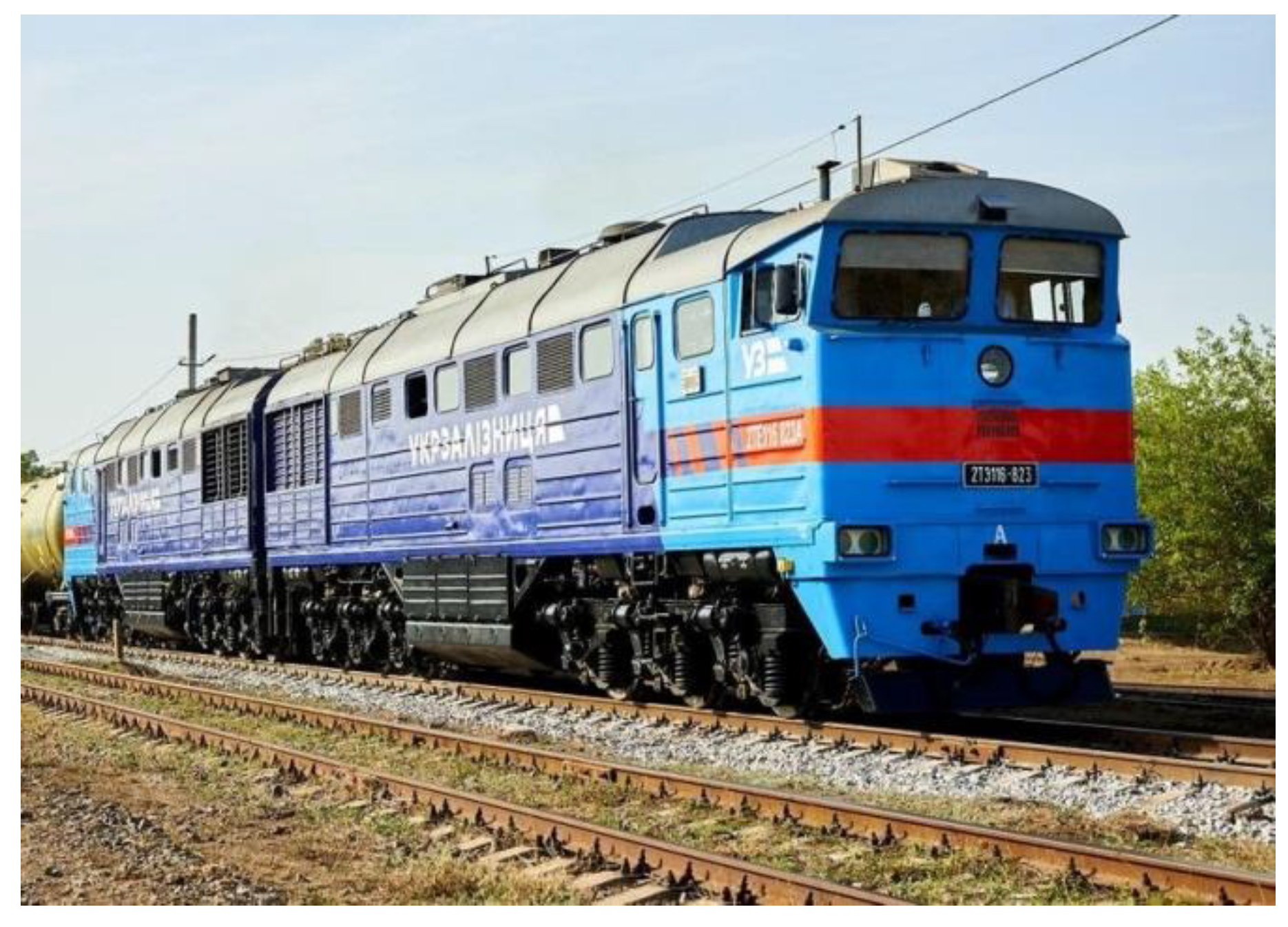
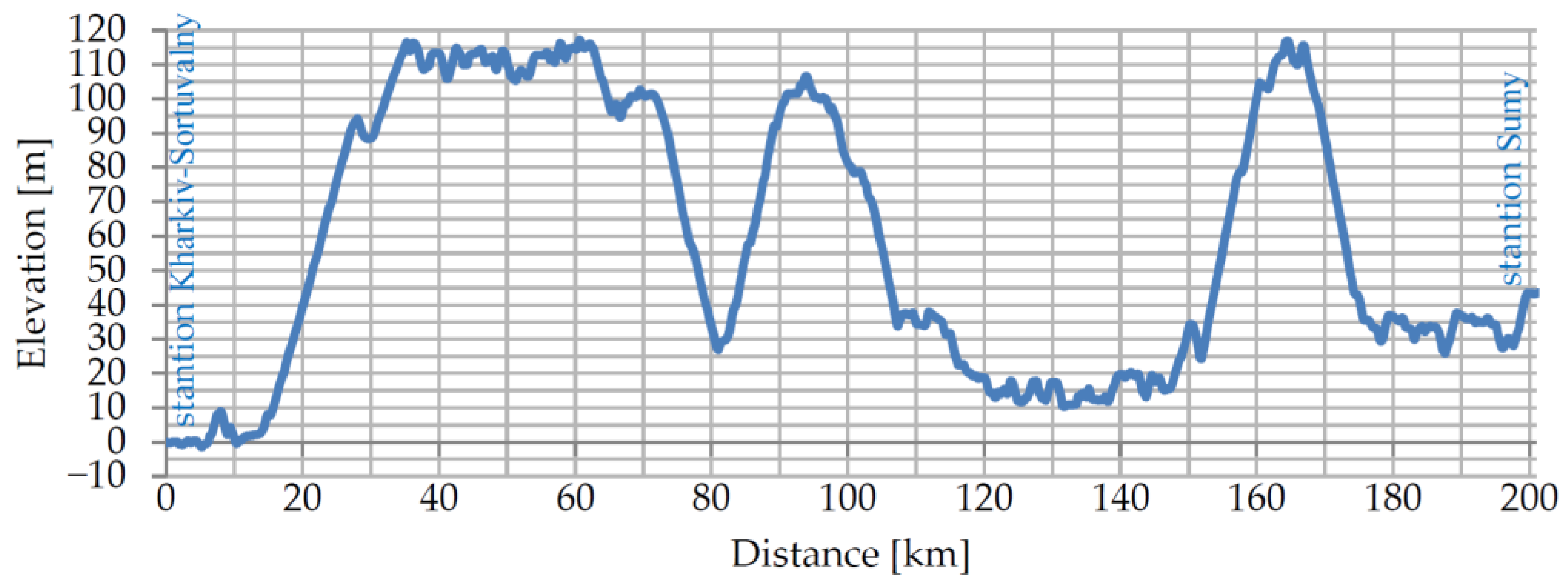

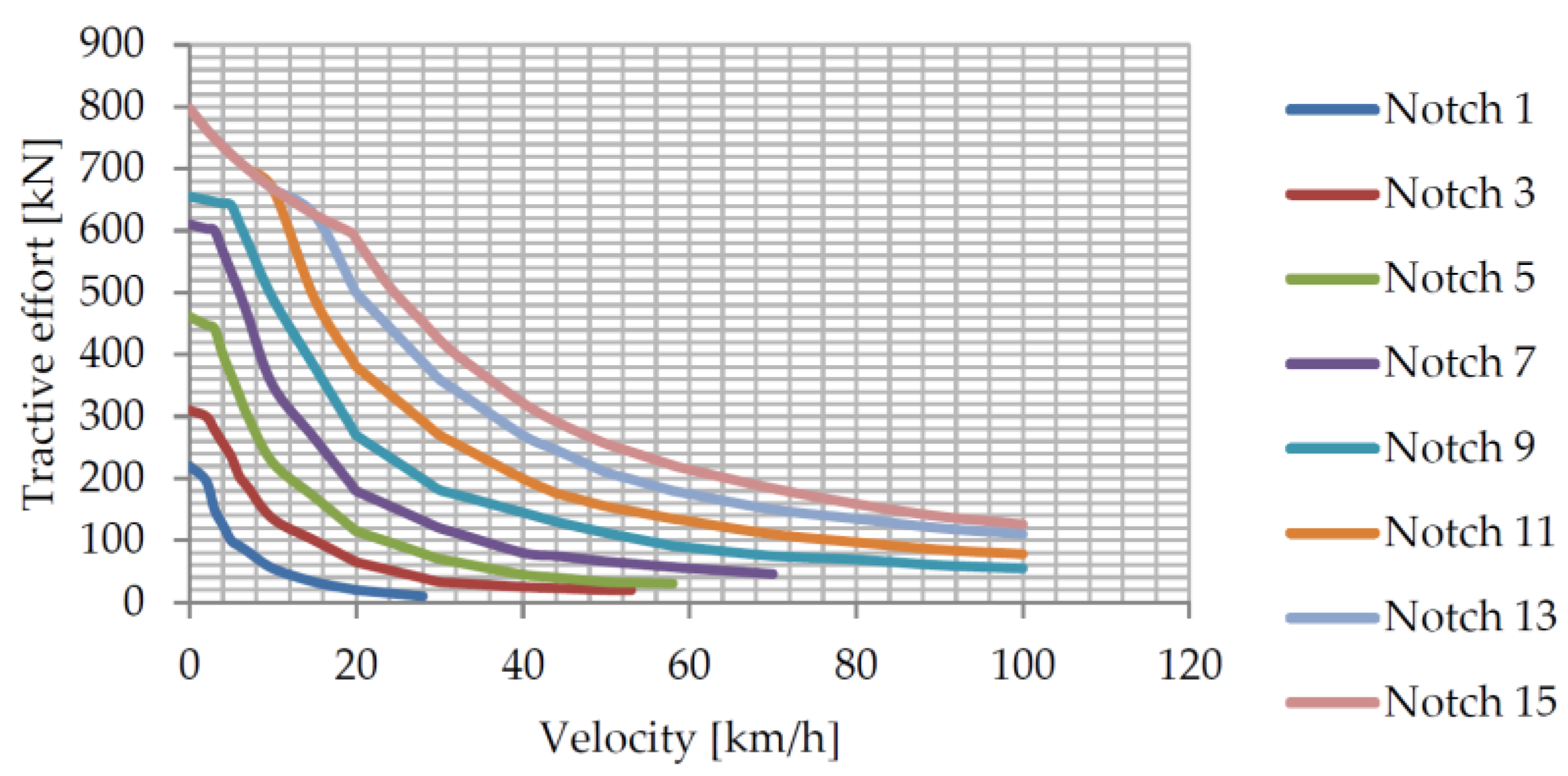
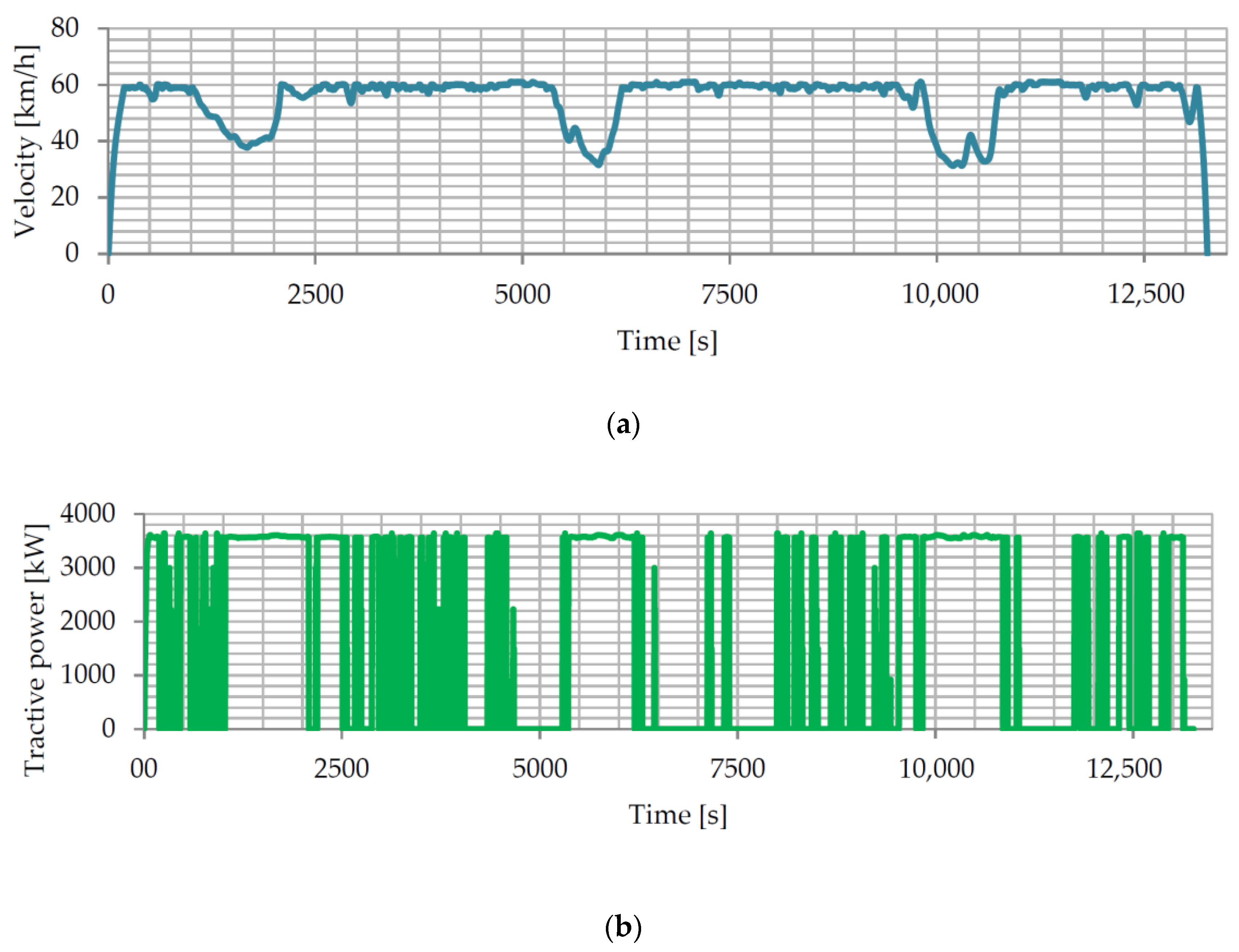
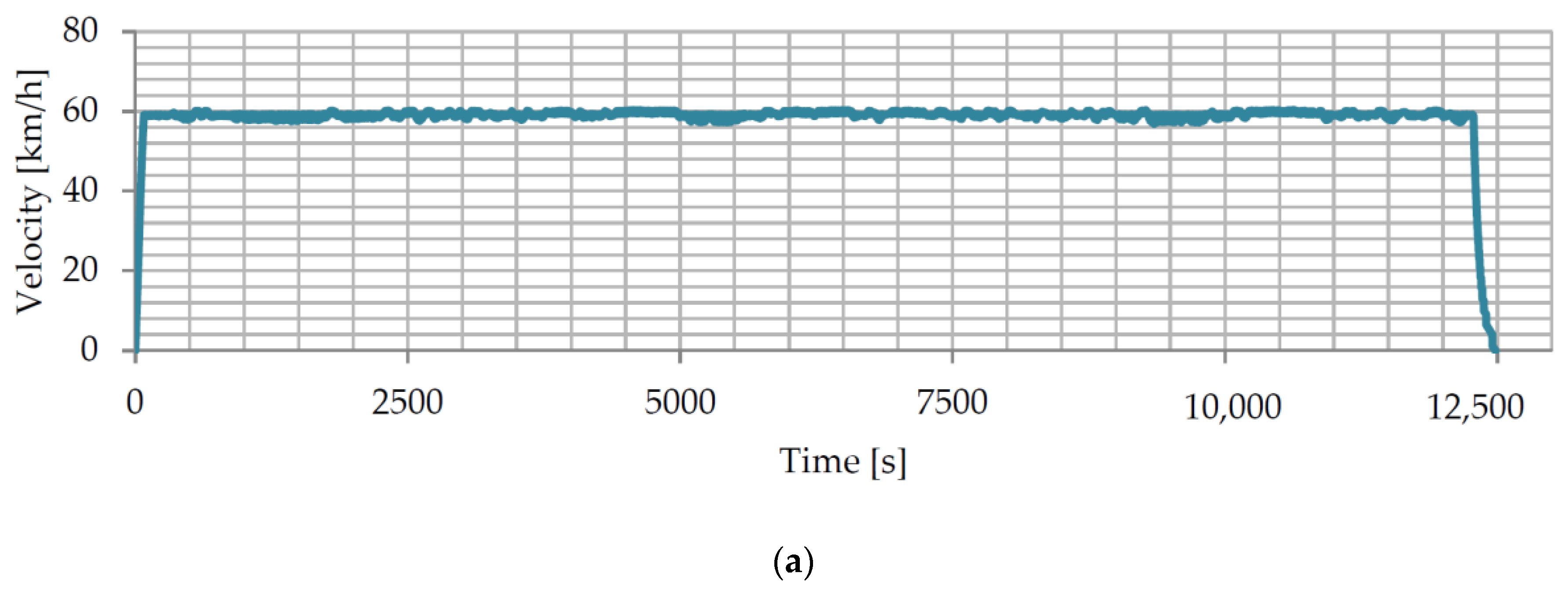
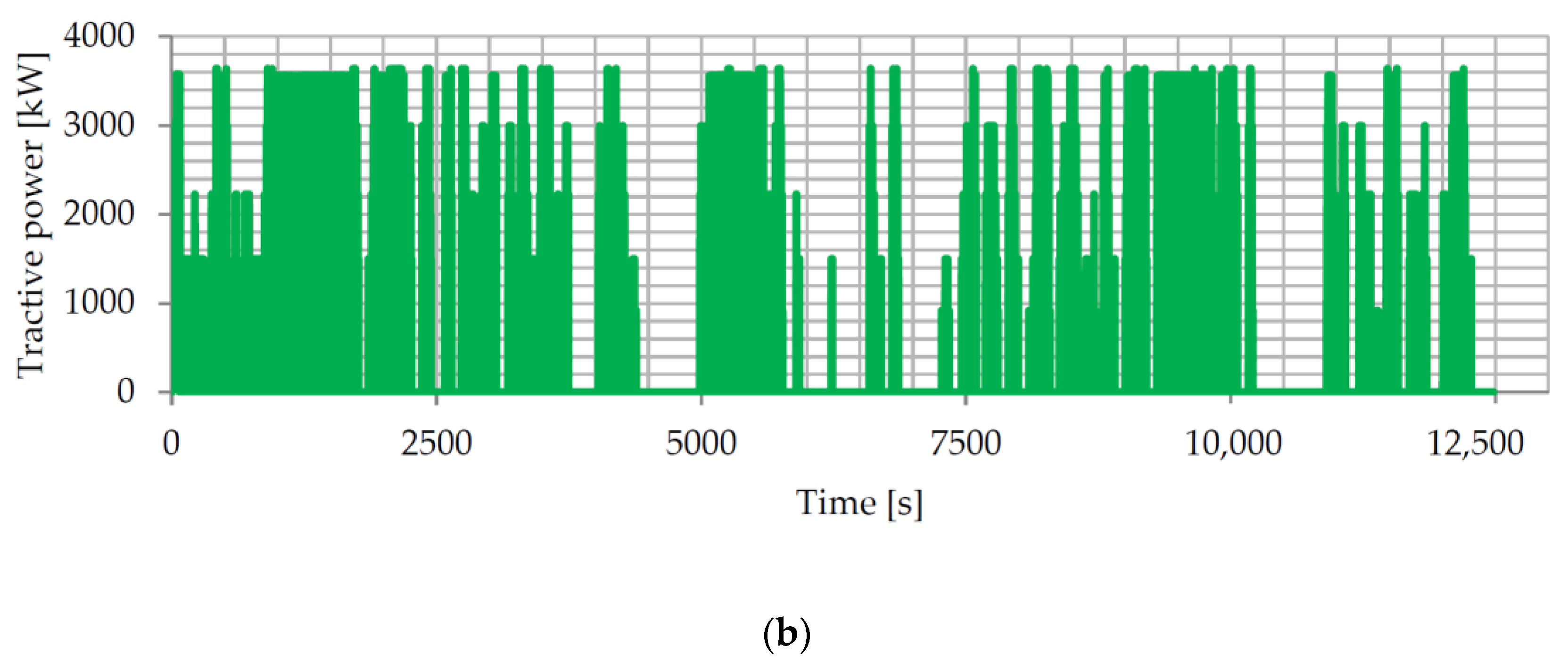
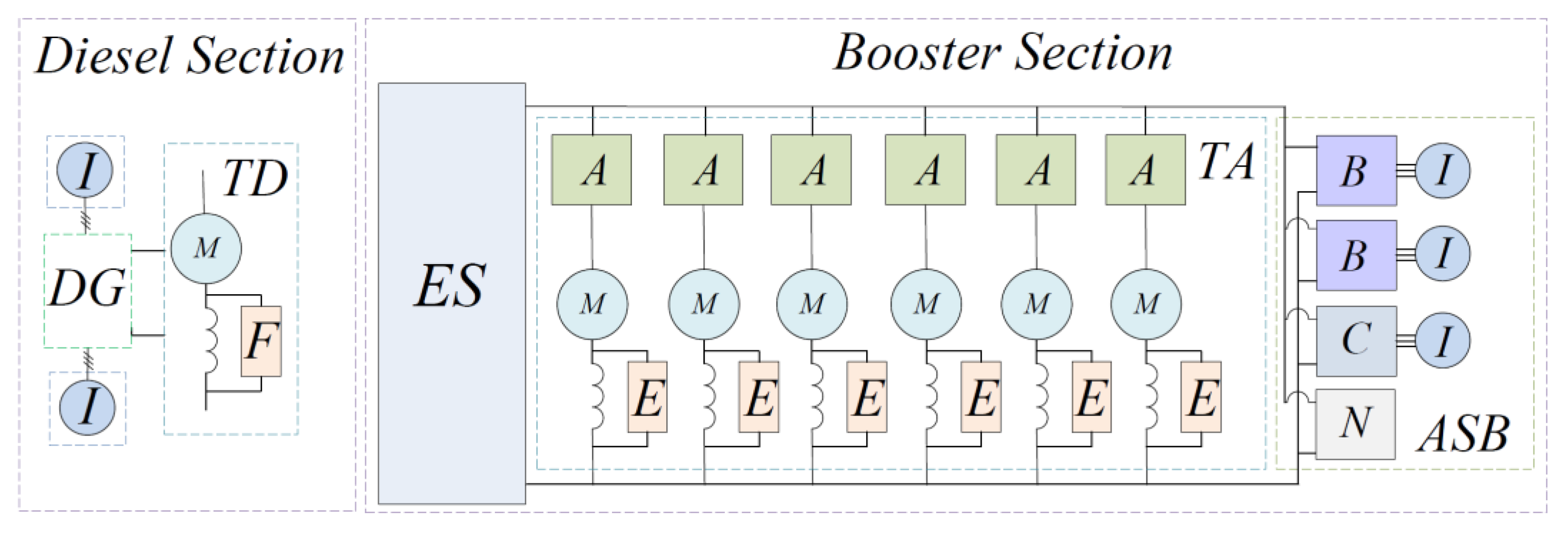
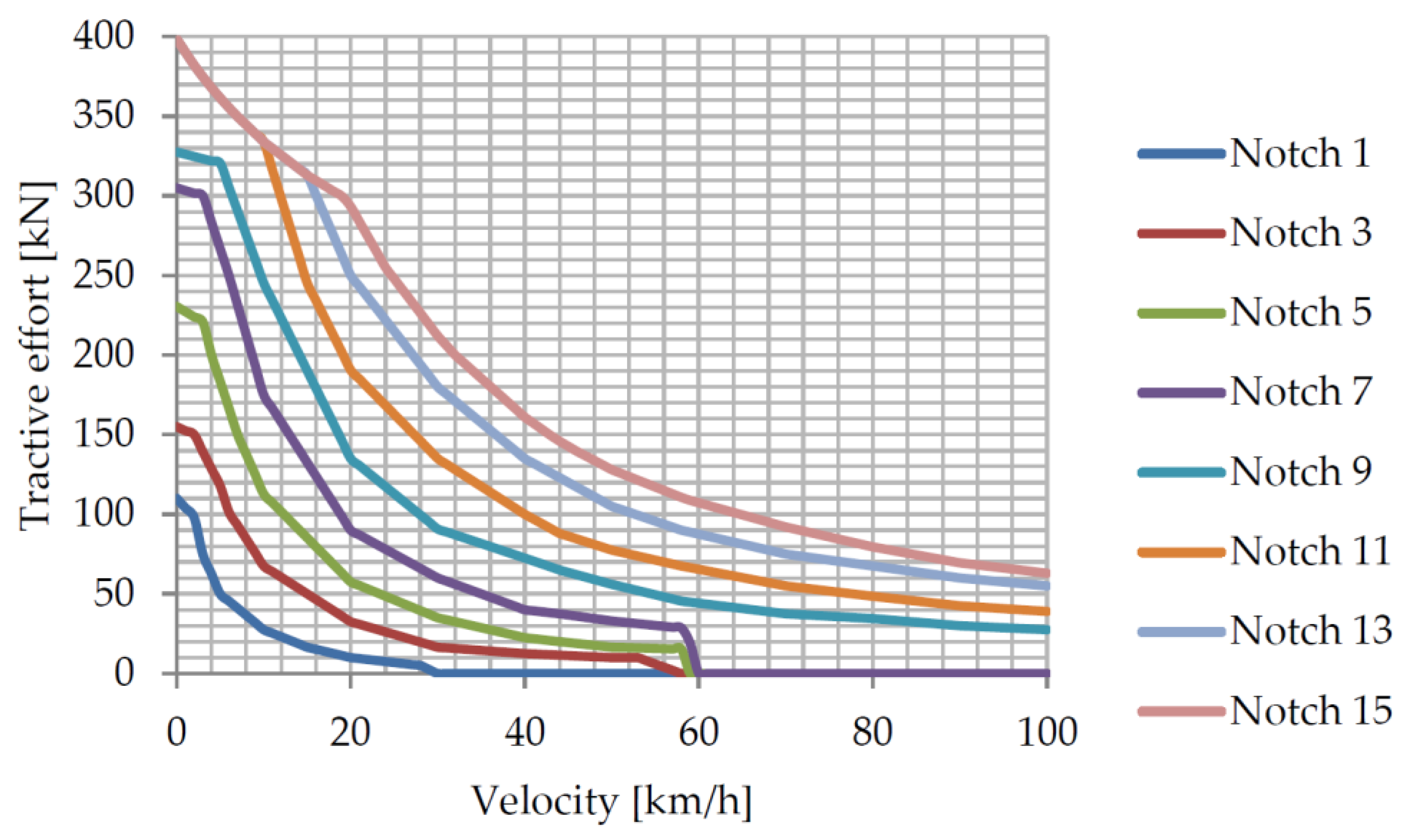
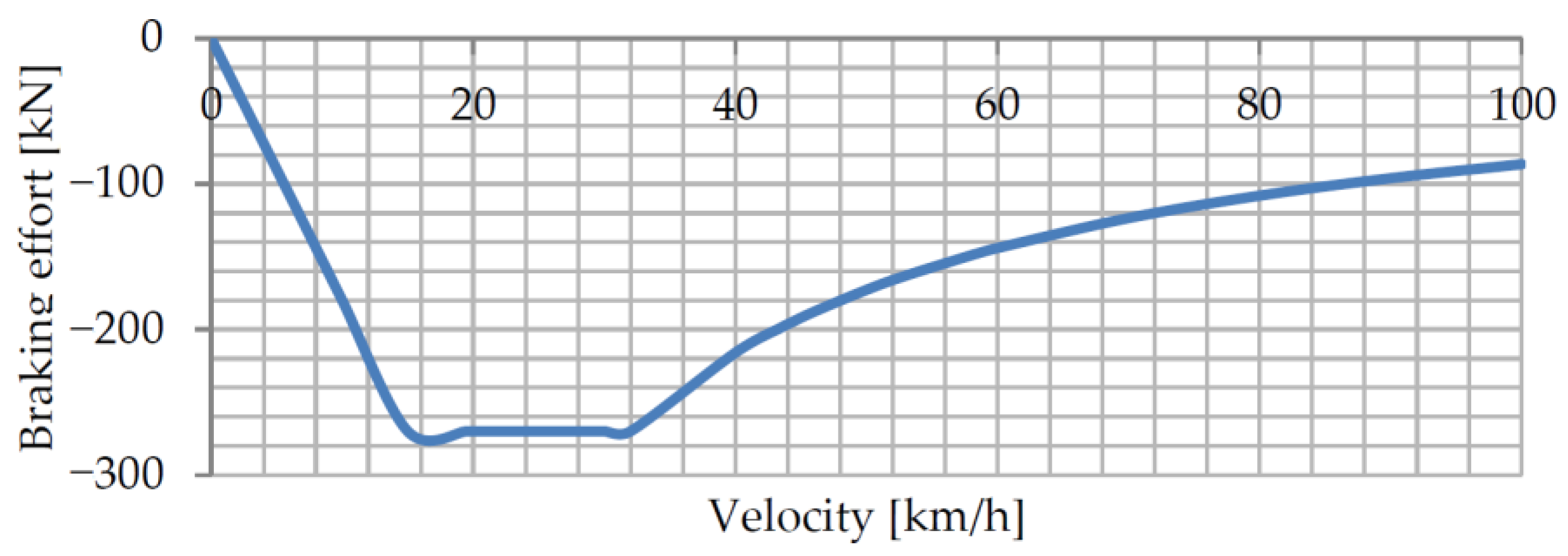
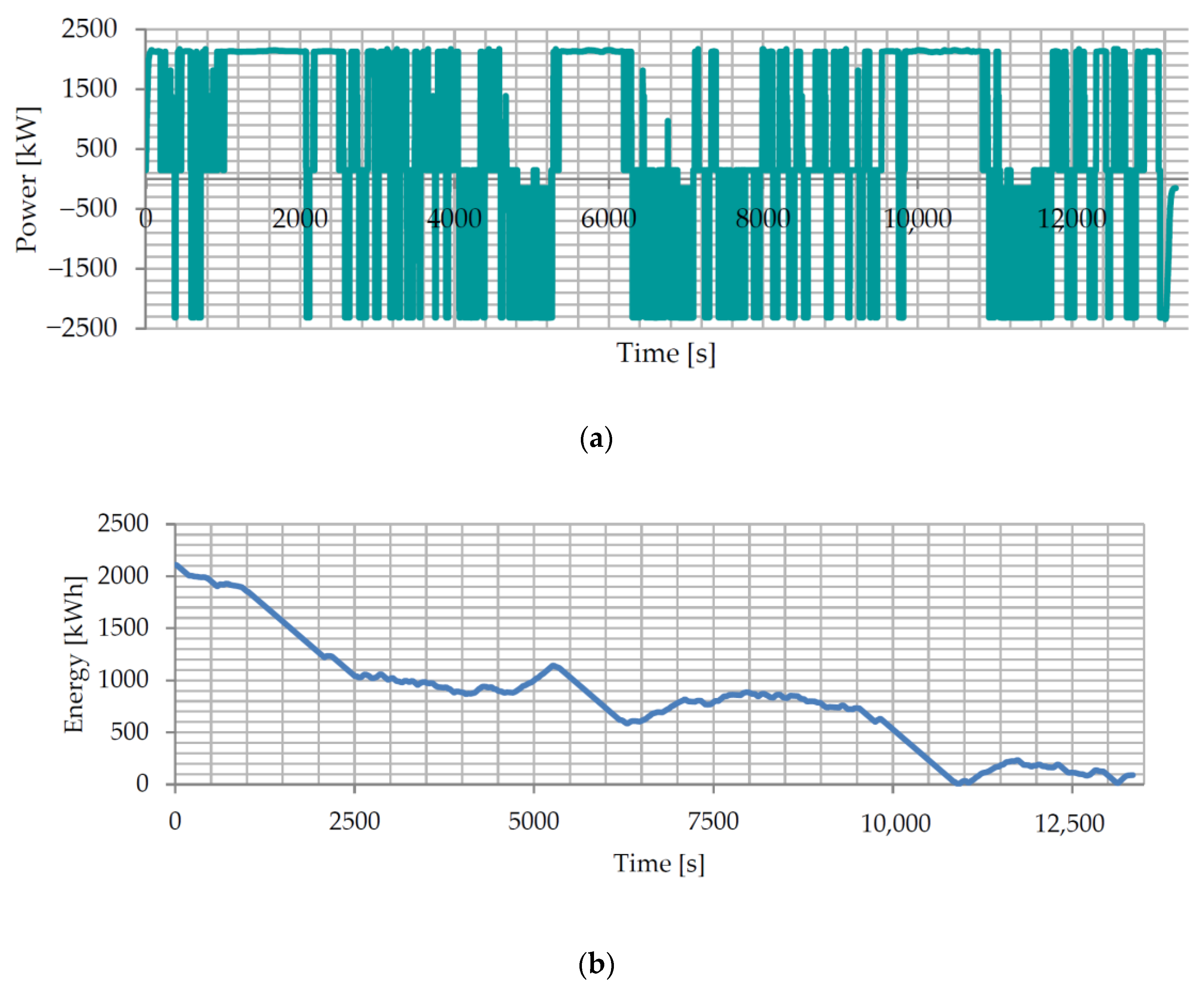
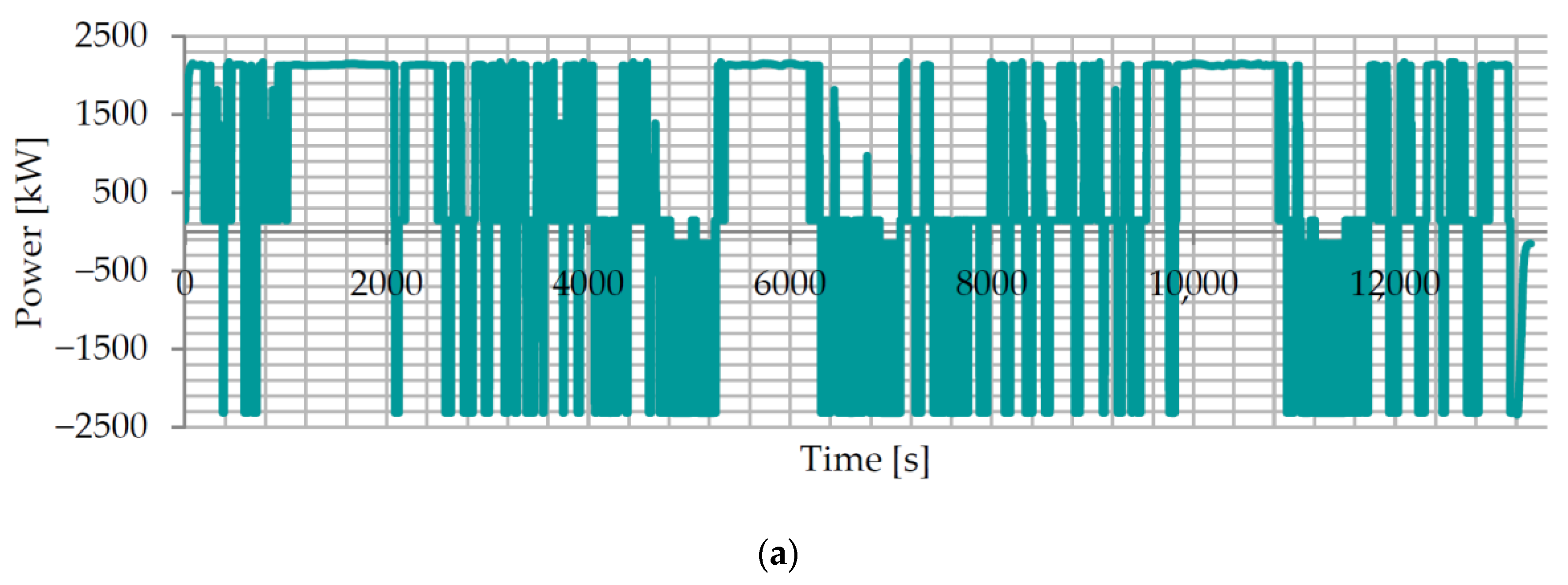
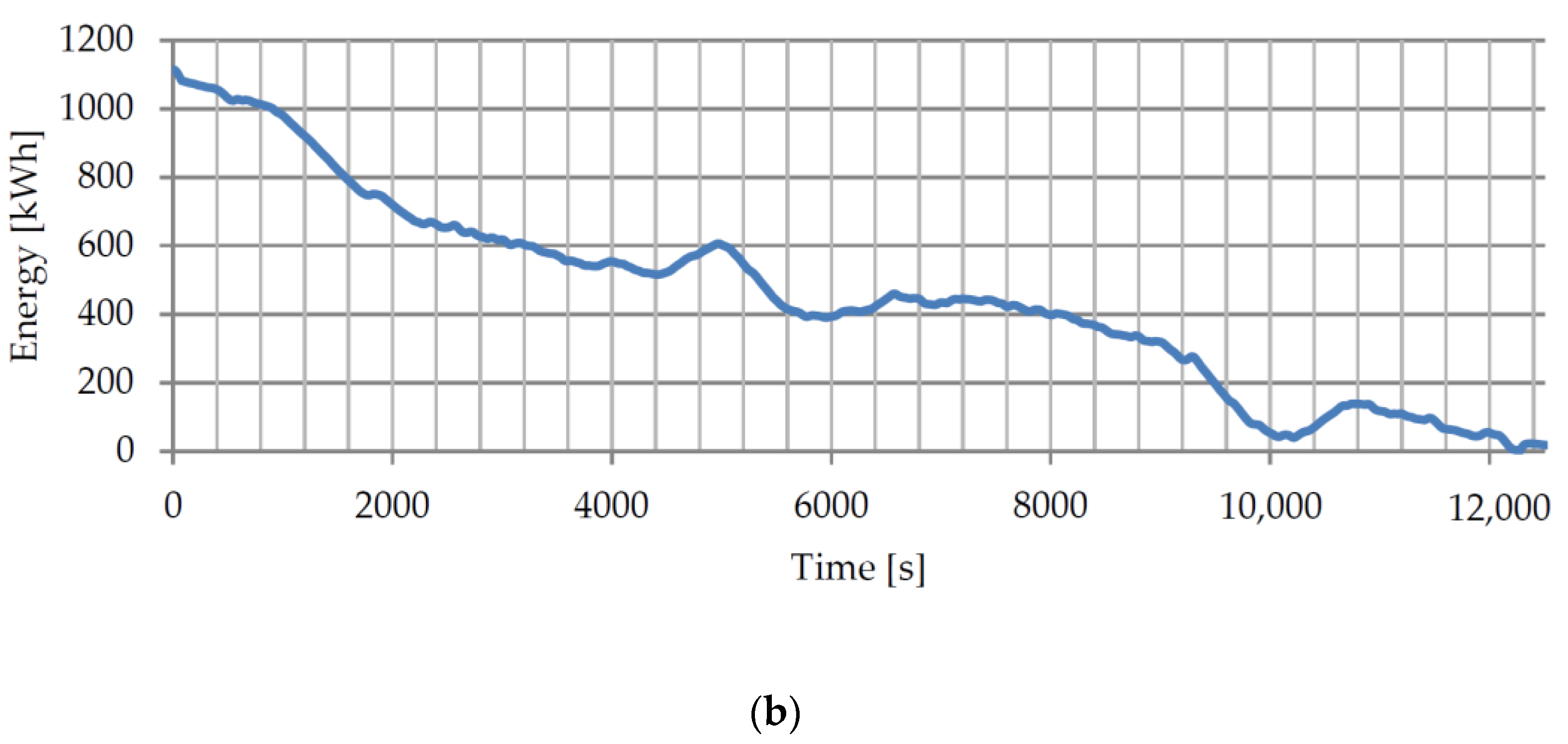

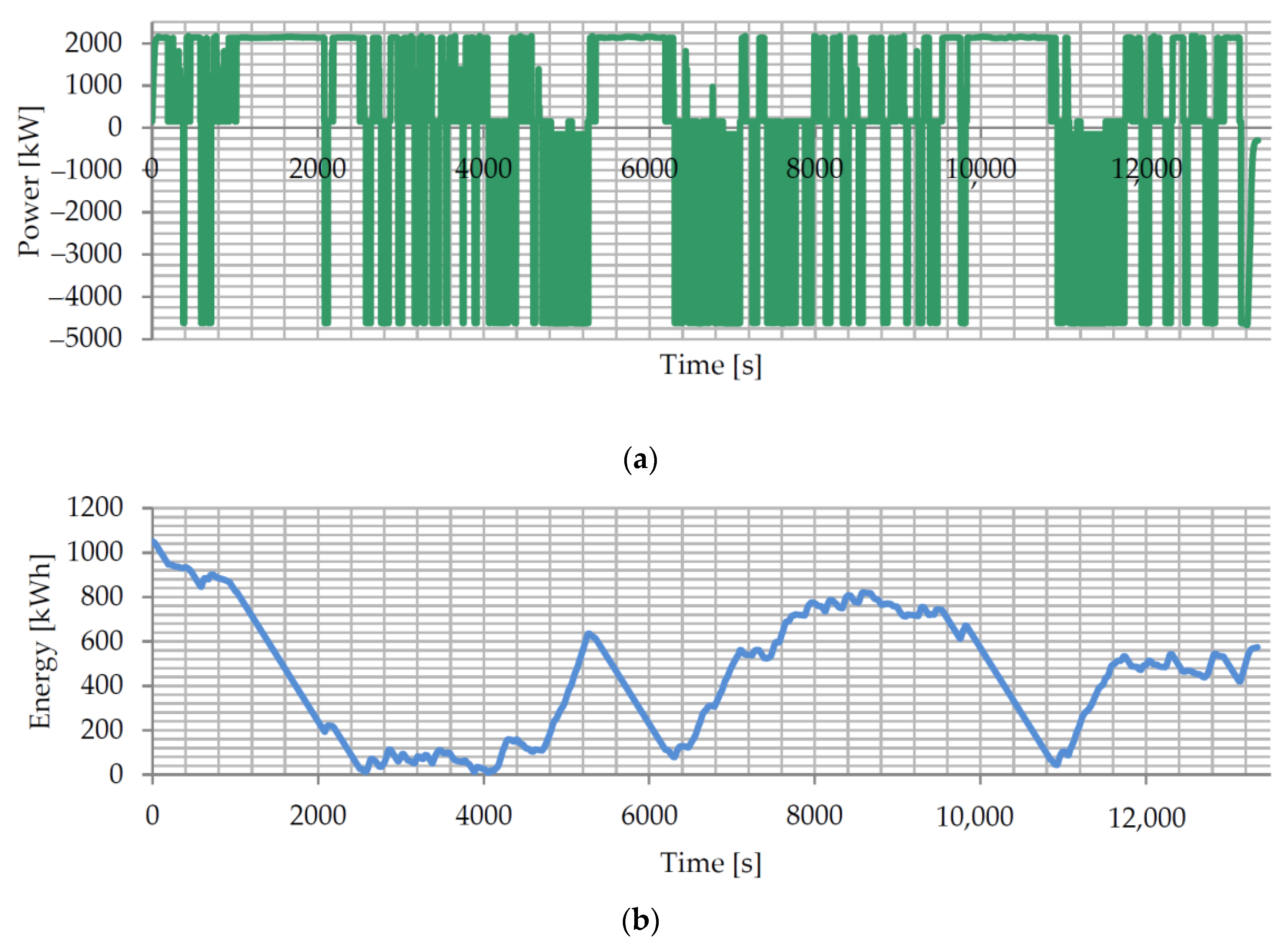
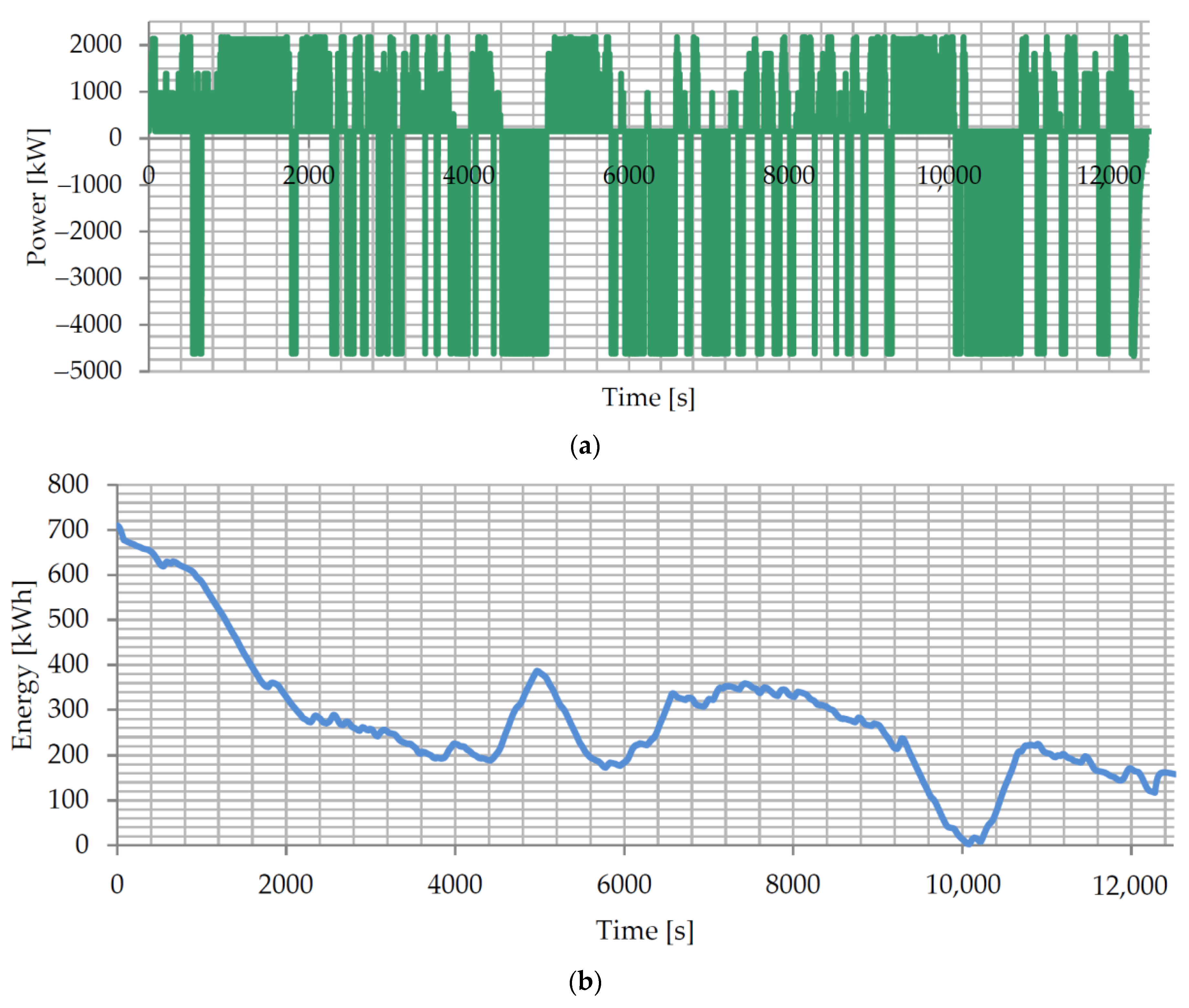
| Driver controller position | 0 | 1 | 3 | 5 | 7 | 9 | 11 | 13 | 15 |
| Power of diesel engines, kW | 2 × 33 | 2 × 180 | 2 × 415 | 2 × 670 | 2 × 990 | 2 × 1320 | 2 × 1660 | 2 × 2000 | 2 × 2250 |
| Fuel consumption by two diesel engines, kg/min | 0.66 | 1.6 | 3.3 | 4.8 | 6.8 | 9.0 | 10.9 | 13.5 | 17.0 |
| Parameter | Movement Direction | |||
|---|---|---|---|---|
| Kharkiv-Sortuvalnyi–Sumy | Sumy–Kharkiv-Sortuvalnyi | |||
| Type of Train | Loaded Train | Empty Train | Loaded Train | Empty Train |
| Duration of movement, s | 13,264 | 12,483 | 13,163 | 12,448 |
| Fuel consumption, kg | 1726 | 837 | 1611 | 780 |
| Work “on the wheel” in traction mode, kWh | 5605.3 | 2081.9 | 5173.9 | 1940.4 |
| Work “on the wheel” of braking forces, kWh | 3830.6 | 1071.5 | 4206.1 | 1190.0 |
| Theoretical accumulation coefficient | 0.544 | 0.423 | 0.648 | 0.488 |
| The coefficient of use of the installed diesel power | 0.881 | 0.524 | 0.876 | 0.521 |
| Diesel engine load factor over time | 0.501 | 0.434 | 0.482 | 0.411 |
| Driver controller position | 0 | 1 | 3 | 5 | 7 | 9 | 11 | 13 | 15 |
| Diesel power, kW | 33 | 80 | 415 | 670 | 990 | 1320 | 1660 | 2000 | 2250 |
| Fuel consumption, kg/min | 0.33 | 0.8 | 1.7 | 2.4 | 3.4 | 4.5 | 5.9 | 6.8 | 8.5 |
| Parameter | Movement Direction | |||
|---|---|---|---|---|
| Kharkiv-Sortuvalnyi–Sumy | Sumy–Kharkiv-Sortuvalnyi | |||
| Type of Train | Loaded Train | Empty Train | Loaded Train | Empty Train |
| Duration of movement, s | 13,345 | 12,524 | 13,212 | 12,461 |
| Fuel consumption, kg | 865 | 422 | 806 | 398 |
| Work “on the wheel” in traction mode, kWh | 5603.1 | 2084.9 | 5162.5 | 1938.5 |
| Work “on the wheel” of braking forces in EDB mode, kWh | 3831.2 | 1070.1 | 4216.7 | 1191.0 |
| Theoretical accumulation coefficient | 0.544 | 0.423 | 0.648 | 0.488 |
| Coefficient of use of the installed diesel power | 0.881 | 0.524 | 0.876 | 0.521 |
| Diesel engine load factor over time | 0.501 | 0.434 | 0.482 | 0.411 |
| Energy accumulated in the accumulator at EDB, kWh | 1336.4 | 473.4 | 1550.7 | 520.0 |
| Actual accumulation rate | 0.238 | 0.227 | 0.301 | 0.268 |
| Energy consumed from ES in traction modes, kWh | 3554.4 | 1642.1 | 3288.2 | 1555.1 |
| Energy that must be stored in the ES before movement, kWh | 2110 | 1115 | 2001 | 1013 |
| Minimum working energy capacity, kWh | 2100 | 1115 | 2001 | 1013 |
| Parameter | Movement Direction | |||
|---|---|---|---|---|
| Kharkiv-Sortuvalnyi–Sumy | Sumy–Kharkiv-Sortuvalnyi | |||
| Type of Train | Loaded Train | Empty Train | Loaded Train | Empty Train |
| Duration of movement, s | 13,345 | 12,524 | 13,212 | 12,460 |
| Fuel consumption, kg | 865 | 423 | 806 | 398 |
| Work “on the wheel” in traction mode, kWh | 5603.1 | 2084.9 | 5162.5 | 1938.5 |
| Work “on the wheel” of braking forces in EDB mode, kWh | 3823.2 | 1072.5 | 4185.7 | 1236.0 |
| Theoretical accumulation coefficient | 0.546 | 0.411 | 0.649 | 0.509 |
| Coefficient of use of the installed diesel power | 0.881 | 0.524 | 0.876 | 0.521 |
| Diesel engine load factor over time | 0.501 | 0.434 | 0.482 | 0.411 |
| Energy accumulated in the accumulator at EDB, kWh | 2672.8 | 946.7 | 3288.2 | 1040.1 |
| Actual accumulation rate | 0.477 | 0.454 | 0.637 | 0.536 |
| Energy consumed from ES in traction modes, kWh | 3550.0 | 1642.1 | 3101.4 | 1555.1 |
| Energy that must be stored in the ES before movement, kWh | 1040 | 710 | 890 | 605 |
| Minimum working energy capacity, kWh | 1040 | 710 | 890 | 605 |
| Compared Parameter | Accumulation only from the Booster Section | Accumulation from Both (Diesel and Booster) Sections | ||||||
|---|---|---|---|---|---|---|---|---|
| Reduction in fuel consumption relative to the basic diesel locomotive, % | ≈50 | ≈50 | ||||||
| Change in the utilization factor of the installed capacity, % | without change | without change | ||||||
| Change in the diesel utilization rate over time, % | without change | without change | ||||||
| Minimum working energy intensity, r. u. | 1 | 1 | 1 | 1 | 0.495 | 0.637 | 0.445 | 0.597 |
| Energy that must be stored in the accumulator before movement, r. u. | 1 | 1 | 1 | 1 | 0.495 | 0.637 | 0.445 | 0.597 |
| Power of the energy storage, r. u. | 1 | 2 | ||||||
Disclaimer/Publisher’s Note: The statements, opinions and data contained in all publications are solely those of the individual author(s) and contributor(s) and not of MDPI and/or the editor(s). MDPI and/or the editor(s) disclaim responsibility for any injury to people or property resulting from any ideas, methods, instructions or products referred to in the content. |
© 2024 by the authors. Licensee MDPI, Basel, Switzerland. This article is an open access article distributed under the terms and conditions of the Creative Commons Attribution (CC BY) license (https://creativecommons.org/licenses/by/4.0/).
Share and Cite
Riabov, I.; Goolak, S.; Neduzha, L. An Estimation of the Energy Savings of a Mainline Diesel Locomotive Equipped with an Energy Storage Device. Vehicles 2024, 6, 611-631. https://doi.org/10.3390/vehicles6020028
Riabov I, Goolak S, Neduzha L. An Estimation of the Energy Savings of a Mainline Diesel Locomotive Equipped with an Energy Storage Device. Vehicles. 2024; 6(2):611-631. https://doi.org/10.3390/vehicles6020028
Chicago/Turabian StyleRiabov, Ievgen, Sergey Goolak, and Larysa Neduzha. 2024. "An Estimation of the Energy Savings of a Mainline Diesel Locomotive Equipped with an Energy Storage Device" Vehicles 6, no. 2: 611-631. https://doi.org/10.3390/vehicles6020028
APA StyleRiabov, I., Goolak, S., & Neduzha, L. (2024). An Estimation of the Energy Savings of a Mainline Diesel Locomotive Equipped with an Energy Storage Device. Vehicles, 6(2), 611-631. https://doi.org/10.3390/vehicles6020028








